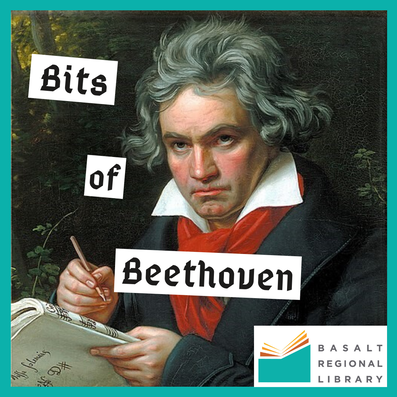 Hello Music Lovers of the Valley, “I wish you music to help with the burdens of life and to help you release your happiness to others.” - Ludwig van Beethoven Art can provide both escape and sustenance during these difficult days. I hope this series of music postings from Basalt Regional Library will inspire you to once again visit some Beethoven masterpieces to discover what they say in times of social distancing. Sadly, we have canceled Amanda Gessler’s Beethoven Piano Sonatas concert that had been scheduled for May 15th, rescheduling TBA. Amanda had planned to play sonatas from Beethoven’s late period, and I will list those in a future posting. I recommend we begin our listening with two piano sonatas from Beethoven’s early period (ca. 1770-1800): the “Pathetique”, Op. 13 (1799) and “Moonlight”, Op. 27 No.2 (1802). You can find performances of these sonatas on YouTube, and I include links to contrasting interpretations of each one. As I note below, I would love to hear back from you about the contrasting styles. The “Pathetique” is a sonata in three movements, the outer movements being stormy and passionate in character and the middle movement the calm between the storms. Beethoven’s repeated use of the grave introduction to the first movement seems to foreshadow the cyclical inner-movement characteristic of later works. As you listen, be aware of the thickness of texture as compared to the piano sonatas of the classical period. For the “Pathetique”, compare these performances: The three movements of the “Moonlight” are arranged slow, moderate, fast, as compared to the fast-slow-fast order usually found in three movement sonatas of the classical period. Carl Czerny describes the first movement as “a nocturnal scene, in which a mournful ghostly voice sounds from the distance.” Listz identified the second movement as “a flower between two chasms,” and Charles Rosen describes the third movement with these words, “its furiousity is astonishing.” For the “Moonlight”, compare: Listen to these two sonatas and be inspired by their tonal beauty!
Recordings of Beethoven are vast, and my initial thought was to suggest particular YouTube sites for your listening. Instead, I decided to suggest for your perusal some names of performers/performances available for viewing on YouTube. These suggestions have been gleaned from valley musicians, Beethoven authorities, and distant musician friends of mine whose music judgments I respect. (I cite these authorities following the performer’s name). So, you might like to hear Horowitz or Rubinstein, the two early masters (Charlotte McLain, Kevin Kaukl). For more recent performers, listen to Richard Goode (Amanda Gessler, Susan Nicholson, Charlotte McLain), Stephen Hough, Alfred Brendel, Claudio Arrau, Martha Argerich, Jonathan Biss, Emmanual Ax, and John O’Conor. And, of course, we should include Kissin, Barenbolm, Askenazy…the list could go on-and-on. This group of contemporary performers is recommended by many, including Marsha Evans of Memphis and Mark Kruczek of New York. I think you will find it very interesting to compare the playing of an early master with that of a contemporary performer. Please share your thoughts with me about the comparison and I will pass your thoughts along to our fellow music lovers. Just go to YouTube and type in the title of the composition and the name of your chosen performer. Next week I will choose two piano sonatas from Beethoven’s middle period. In the meantime, you might also enjoy viewing the video Beethoven A Portrait, also found on YouTube. Although the audio leaves a bit to be desired and the visual is less than refined, the narrative, music, and scenes from Vienna are outstanding. Until later, Charlotte McLain cmclain@basaltlibrary.org
0 Comments
Your comment will be posted after it is approved.
Leave a Reply. |
Adult News & reviewsLibrary news, info about upcoming events, reviews of books and films, and a look at the topics that affect us as a library. Archives
July 2023
|
General |
Borrowing |
About |

 RSS Feed
RSS Feed
